Community Tip - You can change your system assigned username to something more personal in your community settings. X
- Community
- Creo (Previous to May 2018)
- Creo Modeling Questions
- How to change STL faceting of flat circular surfac...
- Subscribe to RSS Feed
- Mark Topic as New
- Mark Topic as Read
- Float this Topic for Current User
- Bookmark
- Subscribe
- Mute
- Printer Friendly Page
How to change STL faceting of flat circular surfaces
- Mark as New
- Bookmark
- Subscribe
- Mute
- Subscribe to RSS Feed
- Permalink
- Notify Moderator
How to change STL faceting of flat circular surfaces
Hello everyone, (First Post Ever Alert![]() )
)
I make a lot of STLs for rapid prototyping and for fea, I want the stl triangles to be arrayed around the center of circular flat surfaces, the way they are when created in DEFORM (http://www.deform.com/).
The only way I have now, is to make all the surfaces either slightly concave or convex. Which works, but sometimes causes issues with the models.
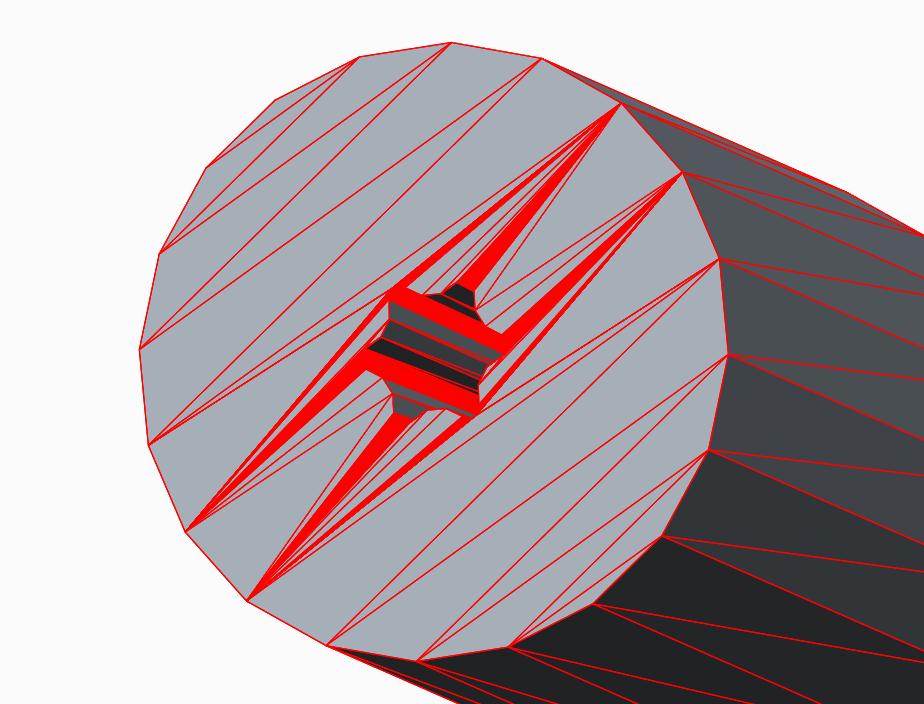
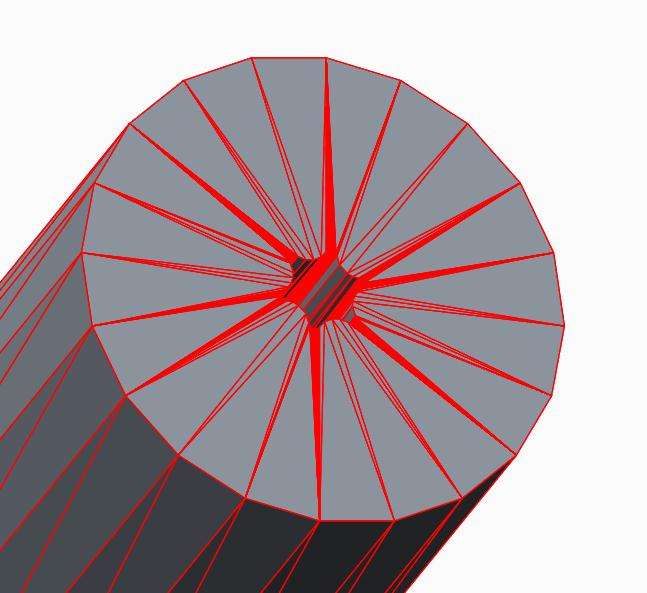
Thanks for any suggestions!
- Mark as New
- Bookmark
- Subscribe
- Mute
- Subscribe to RSS Feed
- Permalink
- Notify Moderator
From my many year of rapid prototyping, the triangular pattern on circles have typically been like your picture on the left irregardless of software. I am not sure how the algorithm is written for developing the triangles. If you change your resolution sometimes it will modify how the triangle are made.
- Mark as New
- Bookmark
- Subscribe
- Mute
- Subscribe to RSS Feed
- Permalink
- Notify Moderator
Back to Dale,
It's nice to know it's not just me.
The only reason I really care, is that in the fea program DEFORM, the mesh is created from these stls and the pattern on the end faces make the mesh behave poorly; which is the reason I do the models with concave/vex surfaces.
The DEFORM software makes stl models like the picture on the right, but I think everything is considered a simple revolve, so that is most likely the reason.
Thanks for your response.
- Mark as New
- Bookmark
- Subscribe
- Mute
- Subscribe to RSS Feed
- Permalink
- Notify Moderator
See how the VRML export does the faceting. If it is more to your liking, you can then import it again and the STL should now follow the VRML facets fairly closely.
I have a feeling that the "layering" of the facets in STL is probably intentional as the STL process is cone by layers rather than logical facet divisions. If the above test fails, it is very likely that this is the case and should be considered an enhancement to a generic STL generation.
Have you looked to see if there are options in the STL export?
- Mark as New
- Bookmark
- Subscribe
- Mute
- Subscribe to RSS Feed
- Permalink
- Notify Moderator
Back to Antonius,
I do like the VRML export better, but after importing and exporting as stl, the results are about the same.
I may have to live without having flat endfaces on my cylinders.
I have looked for STL options, but I haven't found any more than are in the export window. I may do more searching.
My next step is to send it to support and see if they can help (or maybe add it as an enhancement, sometime).
- Mark as New
- Bookmark
- Subscribe
- Mute
- Subscribe to RSS Feed
- Permalink
- Notify Moderator
Here's the thing, if it's a flat surface, the triangulation is completely irrelevant. Really. ONLY if there is some curve to a surface will it matter. In your case with a flat surface and the splined hole, only the amount of triangulation where the spline intersects the surface matters, not the look. The flat surface will ALWAYS be flat, it's just how accurate does the curve on the spline need to be, because the amount of segments where it intersects the flat plane is what determines the accurace longitudinally down the splined hole.
I would NEVER make what should be a flat surface concave or convex simply to make the file look better. The system knows what it's doing, don't worry about it. I've never had an issue and I worked at a place with 2 SLA machines I used constantly for about 2 years.
I haven't created an STL in creo yet, but there should be (read: WAS) settings you could set for, if I remember, chord angle and chord height. They or similar should still exist, just look for them when you create the STL file.
Best of luck.
- Mark as New
- Bookmark
- Subscribe
- Mute
- Subscribe to RSS Feed
- Permalink
- Notify Moderator
Its probably still the same Frank...
- Mark as New
- Bookmark
- Subscribe
- Mute
- Subscribe to RSS Feed
- Permalink
- Notify Moderator
Back to Frank,
True, it is flat as an STL. But, it does make a difference in my FEA analysis program (DEFORM) how the triangulation is oriented. When the mesh is created with a curvature bias, the mesh is definitely affected by the triangulation. The STL models created in DEFORM do not have this issue, and the mesh looks very good.
You are right about the settings for creation, they have even added a few more options, but they don't help my issue. I've been making a lot of STLs for quite a while, so I am familiar with controls, I'm just not happy with the method.
I have a call in to tech support, I will let everyone know if I ever get a better solution than my current workaround (no flat round surfaces)
- Mark as New
- Bookmark
- Subscribe
- Mute
- Subscribe to RSS Feed
- Permalink
- Notify Moderator
Frank,
I should have been a bit more clear in my original post, sorry. I don't do this often.![]()
These pics might have helped explain why I would like a different mesh generation.
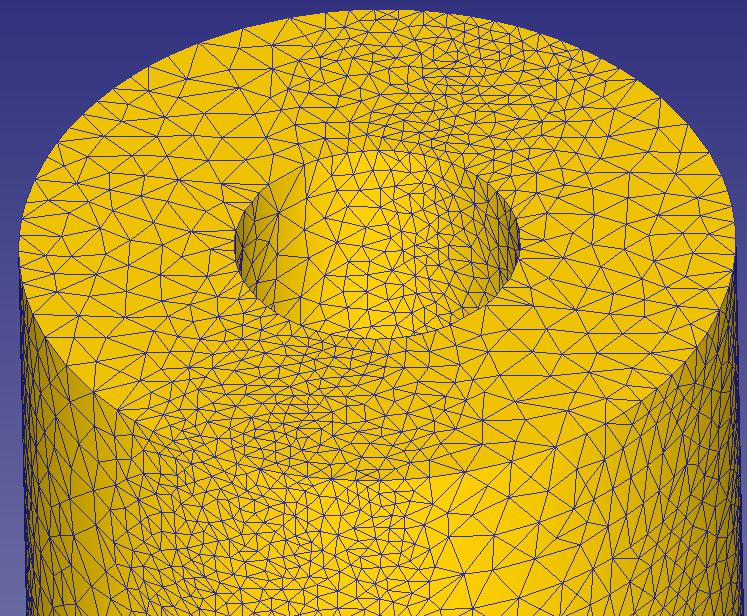
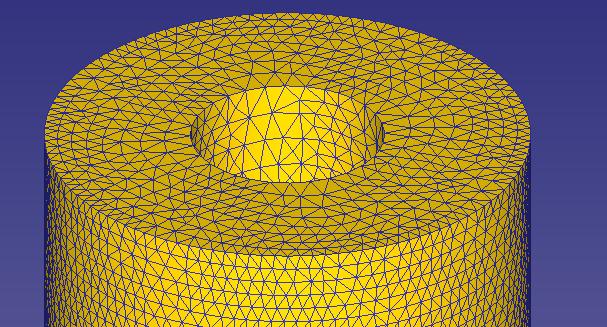

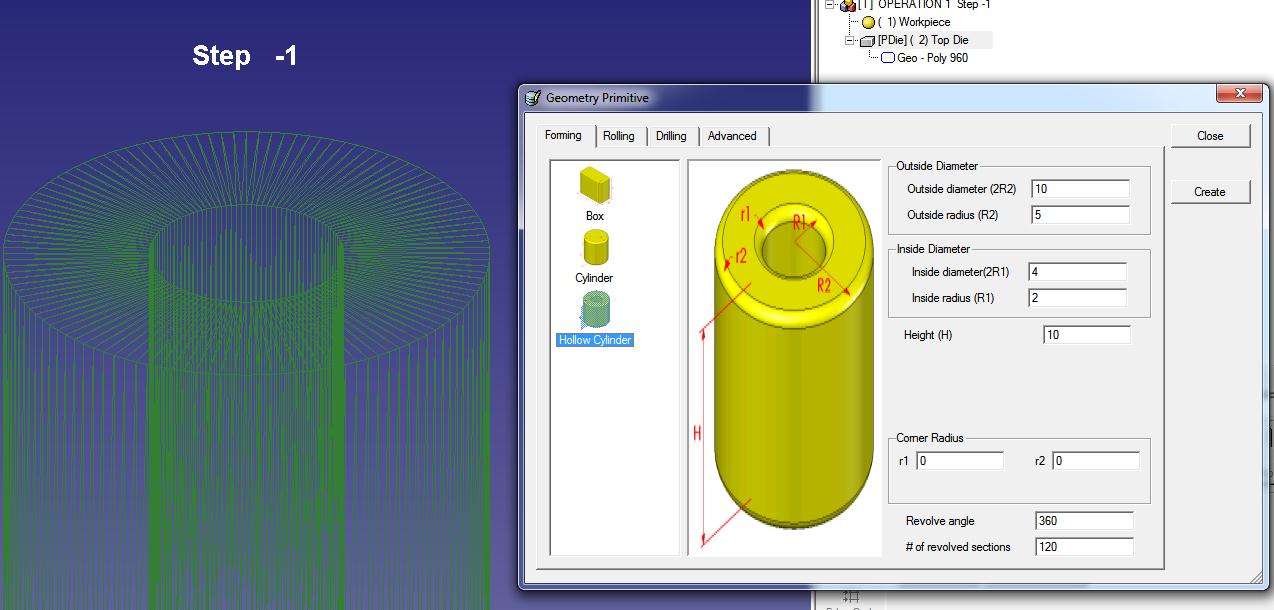
- Mark as New
- Bookmark
- Subscribe
- Mute
- Subscribe to RSS Feed
- Permalink
- Notify Moderator
Sorry, I didn't catch the lower-case "fea" in your post. Why not let your analysis program make the mesh? We have Mechanica and Ansys here and we always let the FEA program mesh it. Is there a reason you're trying to use an STL mesh for FEA?
- Mark as New
- Bookmark
- Subscribe
- Mute
- Subscribe to RSS Feed
- Permalink
- Notify Moderator
Frank,
I am not trying to use an STL mesh for FEA, I am using an STL generated from a model in Creo (and WF 2 in the old days), to creat a 3D mesh in DEFORM.
I also use Creo to make IGES files for import into DEFORM, just because it is so much easier.
DEFORM always makes the mesh. The difference is whether the geometry is imported 2D, 3D or created internally as 2D, revolved 2D or 3D primitives.
I run a lot of 3D simulations and some of the models are much too complicated to create inside DEFORM.
My only question was if it was possible to get the STL triangles to be oriented to the cylinder (edge) instead of linear. The tech support case is on "hold", he didn't tell me it wasn't possible yet, so I still have some hope.
The workaround has worked well for a long time and I will keep using it, unless someone has a solution.
The other workaround is to mesh the Creo STL without curvature sensitivity and then to do a manual remesh with curvature sensitiviy. But it would still be better for me if the STL from Creo, behaved similar to he STL in DEFORM.
- Mark as New
- Bookmark
- Subscribe
- Mute
- Subscribe to RSS Feed
- Permalink
- Notify Moderator
What formats will Deform accept?
- Mark as New
- Bookmark
- Subscribe
- Mute
- Subscribe to RSS Feed
- Permalink
- Notify Moderator
Antonius,
Here is the list.

- Mark as New
- Bookmark
- Subscribe
- Mute
- Subscribe to RSS Feed
- Permalink
- Notify Moderator
STL strikes me as a really clunky format for transferring native solid geometry (and it seems rather poor that Deform won't import 3D STEP or IGES).
I believe Mechanica can generate a NASTRAN mesh - have you tried playing with that?
- Mark as New
- Bookmark
- Subscribe
- Mute
- Subscribe to RSS Feed
- Permalink
- Notify Moderator
Jonathan,
I agree %100 with the file format comment.
As for Mechanica, I don't have a license. I ran a "Creo Simulate Lite" simulation, but I don't think I can extract the mesh. The results didn't look very promising in the geometry area, but I have never used it before.
Is there any way I can use the lite version to make a NASTRAN mesh?
- Mark as New
- Bookmark
- Subscribe
- Mute
- Subscribe to RSS Feed
- Permalink
- Notify Moderator
I believe it can be done at least in full Mechanica (Creo/Simulate) but I must admit I can't immediately find it there, either! We need someone with experience of this - or, ideally, a PTC rep...
- Mark as New
- Bookmark
- Subscribe
- Mute
- Subscribe to RSS Feed
- Permalink
- Notify Moderator
Jonathan,
Thanks for trying, I appreciate it.
I checked on the support page again this morning and my case is still on hold. I hope that means they are seriously looking at it. ![]()
- Mark as New
- Bookmark
- Subscribe
- Mute
- Subscribe to RSS Feed
- Permalink
- Notify Moderator
Hmmm. Perhaps create an STL model, open that, export a STEP files as surfaces only, and then in Import Data doctor remove the surfaces you don't like, then create the ones you want exactly as you want them?
- Mark as New
- Bookmark
- Subscribe
- Mute
- Subscribe to RSS Feed
- Permalink
- Notify Moderator
Not much choice for imports. Looking forward to what PTC comes up with.
- Mark as New
- Bookmark
- Subscribe
- Mute
- Subscribe to RSS Feed
- Permalink
- Notify Moderator
Antonius,
I've always thought that also, and I am also looking forward to a response; Even if they say it's not possible.
- Mark as New
- Bookmark
- Subscribe
- Mute
- Subscribe to RSS Feed
- Permalink
- Notify Moderator
Frank,
I tried and didn't have a lot of success,
Thanks for the suggestion, tho.
- Mark as New
- Bookmark
- Subscribe
- Mute
- Subscribe to RSS Feed
- Permalink
- Notify Moderator
Yeah, I was guessing. What went wrong? I figured the STL would give you 99% of the faets you wanted, and by manually deleting and adding them it might help.
- Mark as New
- Bookmark
- Subscribe
- Mute
- Subscribe to RSS Feed
- Permalink
- Notify Moderator
Frank,
If I did it right (big if), I end up with an stl file, that has no endfaces. From there, I don't know how to put facets back in, the way I want them. If I make surfaces, the facets are created like usual.
- Mark as New
- Bookmark
- Subscribe
- Mute
- Subscribe to RSS Feed
- Permalink
- Notify Moderator
Hi Donald,
This is an interesting thread to me because we use the DEFORM software. I've used DEFORM for a long time but have yet to export STL die models from Creo.
I would like to learn how to learn the optimal STL settings for use in DEFORM for when I submit my first dies.
It appears that you use DEFORM for use in an extrusion type process. We use DEFORM for simulating drop forgings in the die and wedge roll. It is a very good software and their tech support is excellent.
I do hope PTC will be able to help you in tweaking STL settings. Please let us know what you find out.
- Mark as New
- Bookmark
- Subscribe
- Mute
- Subscribe to RSS Feed
- Permalink
- Notify Moderator
Hi Paul,
Using Creo to make my STLs for DEFORM works very well. I'm still figuring out what settings to use. I normally go by file size and how the resolution looks around the smaller features, as well as the quality of mesh I'm going to generate.
I use Creo to build my progressions based upon volumes (lot of relations) and then I make my dies to fit those parts. If they are round dies and punches, I will export the iges files from Creo, this is also working very well for me.
- Mark as New
- Bookmark
- Subscribe
- Mute
- Subscribe to RSS Feed
- Permalink
- Notify Moderator
With the CAD software we are out moding we do have some issues with STL quality. DEFORM has to heal a number of open entities with every job. In the test I did with Creo prior to our purchase the STL model came into DERFORM without any errors. I'm optimistic that the geometry will be cleaner with Creo. This should give us better results.
I will need to establish settings like you suggest for the best quality and performance. Our dies are typically 24 by 22 inches with perhaps 10 inches of height. The most critical thing for us with STL creation will be the ability to have flat surface polygons that are the full length of the flats, otherwise the polygon count will be crazy. We just need to hold tolerances tight inside the impressions itself.
There is a limitation to polygon count in DEFORM in regards to performing Die Stress Analysis. I'm crossing my fingers that there will be adjustability with the export of STL's.
- Mark as New
- Bookmark
- Subscribe
- Mute
- Subscribe to RSS Feed
- Permalink
- Notify Moderator
Paul,
That sounds interesting. I never get to work with the bigger items. Most of my simulations are of small, round objects (fasteners for example)
If you ever have any key (and/or Creo) files you can share, feel free to send me an example (just being curious), especially if you want a second opinion.
A lot of my simulations are considered proprietary and are quite honestly pretty boring ![]() .
.
- Mark as New
- Bookmark
- Subscribe
- Mute
- Subscribe to RSS Feed
- Permalink
- Notify Moderator
UPDATE
Support suggested I start a product suggestion, so I did. I will continue using my workaround whenever necessary.
Thanks to everyone for their suggestions. I really appreciate the feed back I have received from the community![]() !
!
- Mark as New
- Bookmark
- Subscribe
- Mute
- Subscribe to RSS Feed
- Permalink
- Notify Moderator
Hi Don,
Old topic but, have you tried creating just a wedge and patterning it to produce the final shape? I think it would give even better control than concave/convex.
- Mark as New
- Bookmark
- Subscribe
- Mute
- Subscribe to RSS Feed
- Permalink
- Notify Moderator
Holy Zombie thread! ![]() I just ran across it and had basically the same thought. He could build the model as specific surfaces, like you used to have to do in the Olde Days of 2-1/2D AutoCAD. Then see if the STL would treat it differently.
I just ran across it and had basically the same thought. He could build the model as specific surfaces, like you used to have to do in the Olde Days of 2-1/2D AutoCAD. Then see if the STL would treat it differently.

